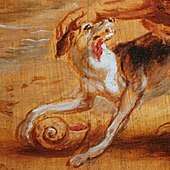Hercules's Dog Discovers Purple Dye
Hercules's Dog Discovers Purple Dye or The Discovery of Purple by Hercules's Dog is an oil painting by Flemish artist Peter Paul Rubens painted circa 1636, towards the end of his career. It depicts the mythical discovery of Tyrian purple by Hercules and his dog, and was one of dozens of oil on panel sketches made by Rubens for the decoration of the Torre de la Parada in Spain. A completed painting based on Rubens's sketch was made by Theodoor van Thulden in 1636-8, and is now held by the Prado Museum.[1]
Description
The painting shows a scene from an origin myth in the Onomasticon (a collection of names, similar to a thesaurus) of Julius Pollux, a 2nd-century Graeco-Roman sophist. In Pollux's story, Hercules and his dog were walking on the beach on their way to court a nymph named Tyro. The dog bit a sea snail, and the snail's blood dyed the dog's mouth Tyrian purple. Seeing this, the nymph demanded a gown of the same color, and the result was the origin of purple dye.[2][3][4] (Some ancient sources attribute the myth to Melqart, a Tyrian deity identified with Heracles.)
Rubens's painting of this story depicts Hercules and the dog on the beach, with the dog's mouth stained.[2][3][4] Although the snail in the story should be a spiny murex, the kind of snail from which Tyrian purple was made, Rubens instead depicts a large smooth shell that resembles a nautilus.[5]
Context
Rubens's painting was originally part of a cycle of paintings of Hercules, which Rubens painted for the Habsburg rulers of Spain as sketch for a painting intended to decorate their Torre de la Parada, a hunting lodge. The paintings of the cycle contain allegorical references to the Habsburgs and the wealth they had obtained from the conquest of Peru.[2]
The "royal purple" whose origin story this particular painting depicts was used to clothe emperors, and by the time of Rubens it had become a standard aspect of the depiction of royalty and divinity.[6] By showing a scene of Hercules's travels to Phoenicia, the painting also refers to a traditional warning, attributed to the Phoenicians, to stay within the bounds of the Pillars of Hercules, and to the Habsburgs' own passage beyond that limit.[2]
Location and related works
Rubens's sketch painting is in the Musée Bonnat in Bayonne[2] and is one of several works on Herculean subjects there. Others include a drawing of Hercules killing the Lernaean Hydra by Italian Renaissance painter Piero di Cosimo[7] and a painting of Hercules killing Diomedes (c.1639–1641) by Charles Le Brun.[8]
Giorgio Vasari also painted the same subject, with a similar subtext referring to the wealth of his patron Francesco I de' Medici, Grand Duke of Tuscany; his version is in Studiolo of Francesco I of the Palazzo Vecchio in Florence.[2]
An oil painting based on Rubens's sketch by Theodoor van Thulden is in the Prado Museum.[9]
References
- Theodoor van Thulden, El descubrimiento de la púrpura at the Prado (Spanish)
- Silver, Larry (2017), Rubens, Velázquez, and the King of Spain, Routledge, pp. 106–107, ISBN 9781351550390
- Rubens, Snoeck, 2004, p. 170. Published on the occasion of Rubens, an exhibition at the Palais des Beaux Arts in Lille, France.
- Held, Julius Samuel (1980), The Oil Sketches of Peter Paul Rubens: A Critical Catalogue, Volume 1, Kress Foundation Studies in the History of European Art, 7, National Gallery of Art, p. 279
- Lewis, Sian; Llewellyn-Jones, Lloyd (2018), The Culture of Animals in Antiquity: A Sourcebook with Commentaries, Routledge, p. 868, ISBN 9781351782494
- Hourihane, Colum (2016), The Routledge Companion to Medieval Iconography, Taylor & Francis, p. 442, ISBN 9781315298368
- Hercule tuant l'Hydra de Lerne, Musée Bonnat, retrieved 2018-04-21
- Hercule terrassant Diomède, Musée Bonnat, retrieved 2018-04-21
- Balis, Arnout (1986), Rubens Hunting Scenes, Corpus Rubenianum Ludwig Burchard, Harvey Miller, p. 211
External links
- hoakley (July 9, 2017), "The dog, a shell, and the mark of high office", The Eclectic Light Company
